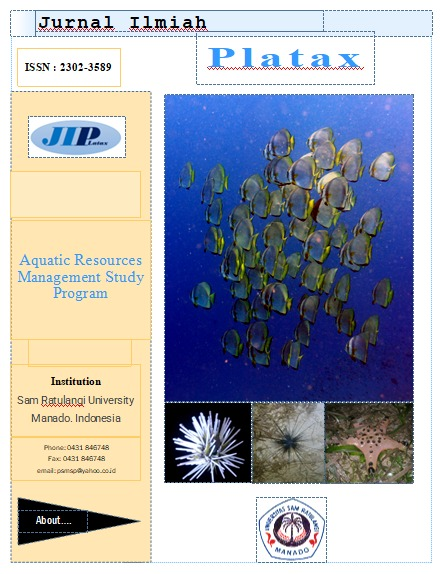Study of the Use of Seagrass Bait on Bebihe Catches in the waters of the Sea Beg, South Central Tabukan District, Sangihe Islands Regency
Keywords:
Bebihe, Seagrass, Bait, Seagrass Meadow FishAbstract
Abstract
Bubu fisheries have developed well in all Indonesian waters, especially in coastal areas that have coral reef and seagrass habitats. Generally, the commodities targeted for fishing are types of reef fish and seagrass beds that have a high selling value, such as snapper, grouper, baronang, yellowtail, lobster, octopus, and others. Bubu fishing gear or traps called bebihe local people are one of the fishing gear used to catch demersal fish or reef fish. The success of the bubu fishing operation is greatly influenced by the construction of the bebihe fishing gear itself and the treatment of the bait used. The use of seagrass bait, allegedly can increase the catching ability of the bebihe. However, scientific information on the use of seagrass as a bait for bebihe for fishing is not yet available. Therefore, the purpose of this study is to determine the effectiveness of seagrass baits with the comparison of kitefish in the operation of bebihe; and identify the types of fish caught.
This research was carried out in the waters of Beeng Laut island, South Central Tabukan District, Sangihe Islands Regency; is based on experimental methods. Six bebihe units were operated during nine trips to collect data; where three units use seagrass bait of the type Thalassia hemprichii, and the other three units use kite fish bait; and then the catch data is analyzed by a t-test.
The catch of bebihe during the study amounted to 363 heads, as many as 345 were caught with seagrass baits, and 18 were caught with kite baits. Analysis of the t-test showed that at t count = 5.480 > t table 0.05;8 = 2.306; where this explains that the use of seagrass bait on bebihe, gives a noticeablely different catch compared to kitefish bait.
References
Almada, D.P. 2001. Studi tentang waktu makan dan jenis umpan yang disukai kepiting bakau (Scyllaserrata) http://repository. ipb.ac.id/bitstream/handle/123456789/14186/C01dpa. Pdf ? Sequence = 1.
Gunarso, W. 1985. Tingkah Laku Ikan Dalam Hubungannya Dengan Alat, Metoda, dan Teknik Penangkapan Ikan. Diktat kuliah (tidak dipublikasikan). Bogor: Departemen Pemanfaatan Sumberdaya Perikanan, Fakultas Perikanan, Institut Pertanian Bogor. 149 hal.
Haeruman, 2000. Ilmu Usaha Tani. Penebar Swadata. Jakarta.
Hutomo, M. 1985. Telaah Ekologik Komunitas Ikan padang lamun (Seagrass, Antophyta) di perairan Teluk Banten. Disertasi Fakultas Pasca Sarjana IPB. Bogor.
Reppie, E. 2010. Pengaruh Minyak Cumi Pada Umpan Bubu Dasar Terhadap Hasil Tangkapan Ikan-Ikan Karang. Jurnal Perikanan Dan Kelautan Tropis. Vol Vi, No. 3. Desember 2010. Issn 1411-9234 (hal. 140-143).
Reppie, E. 1989. A Mathematical Study on Chatching Mechanisms of pot fishery. Master Thesis. Laboratory og Fisheries resources management system. Department of marine science and technology. Tokyo university of fisheries. 63 p. (unpublished).
Sainsbury, 1982. Commercial Fishing Methods: An Introduction to Vessels and Gears. London: Fishing News Books. 119 p.
Steel, R.G.D. and J.H. Torrie, 1989. Principles and procedures of statistics. Approach. 2nd ed. Mc Graw Hill International Book Company. London. 633 p.
Sudjana, N. 1994. Desain dan Analisis Eskperimen. Edisi III. Tarsito. Bandung.
Terrados, J., C.M. Duarte. 2003. Seagrass Ecosystem, South east Asian.
Downloads
Published
How to Cite
Issue
Section
License
Copyright (c) 2022 Jerialdy Larungkondo, Ivor Lembondorong Labaro, Fransisco P.T. Pangalila, Johnny Budiman, Lefrand Manoppo, Fanny Silooy

This work is licensed under a Creative Commons Attribution-NonCommercial 4.0 International License.
COPYRIGHT
Authors who publish with this journal agree to the following terms:
Authors hold their copyright and grant this journal the privilege of first publication, with the work simultaneously licensed under a Creative Commons Attribution License that permits others to impart the work with an acknowledgment of the work's origin and initial publication by this journal.
Authors can enter into separate or additional contractual arrangements for the non-exclusive distribution of the journal's published version of the work (for example, post it to an institutional repository or publish it in a book), with an acknowledgment of its underlying publication in this journal.
Authors are permitted and encouraged to post their work online (for example, in institutional repositories or on their website) as it can lead to productive exchanges, as well as earlier and greater citation of the published work (See The Effect of Open Access).




















